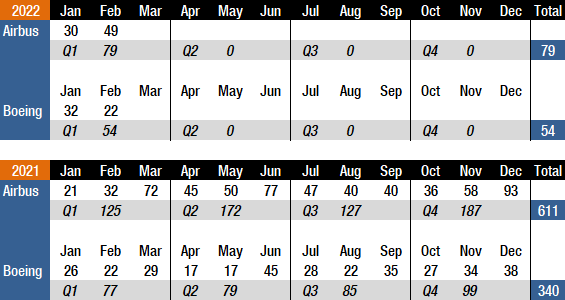Airbus Expects to Deliver 720 Commercial Jets in 2022. Boeing Plans 737 MAX Production Hike to 47 Aircraft per Month Next Year
by J. Kasper Oestergaard, European Correspondent, Forecast International.


Boeing and Airbus delivered 22 and 49 commercial jets in February 2022, compared to 22 and 32 deliveries, respectively, in the same month last year. Year to date, Boeing and Airbus have delivered 54 and 79 aircraft, compared to 48 and 53, respectively, in January and February of last year. With only 22 shipments in February, Boeing had a quiet month but is still six aircraft ahead of the first two months of 2021. Airbus is now 26 jets ahead of last year’s shipment totals to date.
Following a more than challenging 2020 due to the COVID-19 pandemic, 2021 was a year of recovery for the two largest commercial plane makers. 2022 is expected to be another year of recovery for the commercial aircraft manufacturing industry. However, Boeing and Airbus still have quite a way to go before deliveries are back to pre-pandemic levels. For the full year 2021, Boeing delivered 340 aircraft, compared to 157 and 380 in 2020 and 2019, respectively. Boeing’s last “normal” year was 2018 – before COVID and the 737 MAX grounding – when it delivered 806 jets, a level that will likely not be recaptured before 2024 or 2025. The past three years have been extremely challenging for Boeing but, despite ongoing Dreamliner quality issues, things are now looking brighter than at any time since March 2019, when the second 737 MAX crash occurred. Orders are strong and deliveries have surged from the 2020 lows, with another sharp increase expected this year. In addition, the 737 MAX is poised to resume commercial flights in China any day now – well over a year after the U.S. Federal Aviation Administration (FAA) ungrounded the aircraft in November 2020.
In 2021, Airbus delivered 611 aircraft and won the deliveries crown for the third year in a row. Deliveries were up from 566 in 2020 but remain well below the company’s all-time record high of 863 shipments in 2019. Airbus is expected to retain the deliveries lead for the foreseeable future due to the company’s comfortable backlog lead over its American rival. Prior to 2019, Boeing had out-delivered Airbus every year since 2012.
As indicated above, in February 2022, Boeing delivered 22 jets, including 20 737s (all MAX), one 747-8F, and one 777F. The 737 program is currently producing at a rate of 27 per month, up from 19 by the end of October 2021, and continues to progress toward a near-term target of 31 per month. According to Reuters, Boeing has preliminary plans to boost 737 production to 38 jets per month in the first half of 2023, followed by another increase to 47 jets per month by the end of 2023. No 787s were delivered in February. Boeing suspended Dreamliner deliveries in May 2021 for the second time in less than a year. The FAA is reviewing Boeing’s method for inspecting and evaluating the aircraft to ensure it meets federal safety regulations. In February, the head of the FAA, Steve Dickson, stated that the agency needs a “systemic fix” from Boeing to address Dreamliner production issues and would not allow the company to self-certify individual new jets when deliveries resume. However, the FAA has acknowledged that Boeing is heading in the right direction. The FAA wants Boeing to ensure it has a robust plan for the rework that it performs on a large number of new 787s in storage and demonstrate that its delivery processes are stable. According to Boeing, the company is continuing to complete comprehensive inspections across the 787 production system and within the supply chain, while holding detailed, transparent discussions with the FAA, suppliers, and customers. The company continues to perform rework on 787 airplanes in inventory and is engaged in detailed discussions with the FAA.
At the end of last year, Boeing had 110 Dreamliners in storage (manufactured but not yet certified). The current 787 production rate is approximately two aircraft per month, and Boeing expects to continue at this rate until deliveries resume and then return to five per month over time. It is currently unknown when deliveries will be allowed to continue. The 777 program will get a new addition in late 2023 with the first delivery of the 777X, and Boeing announced recently that it will increase the 777/777X production rate from two to three per month in 2022. On January 31, 2022, Boeing launched a new 777X-based freighter, thereby expanding its 777X and cargo portfolio. Qatar Airways will be the 777-8F launch customer.
In February 2022, Airbus delivered 49 jets, including four A220s, 36 A320s (all NEO), three A330s, and six A350s. During 2021, Airbus steadily increased A320 production from 40 per month to 43 in Q3 2021 before finishing the year at a rate of 45 per month. Production will continue to be increased until reaching a monthly rate of 65 by summer 2023. Airbus has also discussed a scenario with a rate of 70 by Q1 2024. Longer term, the company is investigating opportunities for rates as high as 75 by 2025. The A220, meanwhile, is being produced at a rate of five aircraft per month. The rate will be increased to six in early 2022 – with a monthly production rate of 14 envisioned by the middle of the decade. The A350 production rate currently averages five per month and will be increased to six by early 2023. Airbus is currently producing two A330s per month, a rate that will be increased to nearly three aircraft by the end of 2022.
In 2021, Airbus launched the new A350 freighter, or A350F, which is a major and much-needed boost to the company’s competitiveness in the cargo segment. Boeing has long dominated the cargo space with its 737-800BCF, 767-300BCF, 767-300F, 777F, 777-8F and 747-8F offerings. Until now, Airbus has only offered the A330-200F, which has not performed well in competition against Boeing’s popular 767-300F. With the launch of the A350F, it appears Airbus is getting serious about capturing more of the cargo aircraft market. The A350F, which carries up to 120 tons (109 metric tons) of cargo, received its first order in November and will predominantly compete with the 777F. In comparison, the 777F has a cargo capacity of up to 112 tons (102 metric tons). In December 2021, Airbus delivered the 251st and final A380 to Emirates. The A380 is an impressive feat of aeronautical engineering and will, despite its lack of financial success, be forever enshrined in the annals of aviation history. With 123 A380s purchased, Emirates took delivery of nearly half the A380 fleet and currently operates 121 of the superjumbos.
Turning to the February orders review, Boeing had a satisfactory month and booked three orders for a total of 37 jets. The company also reported five cancellations (one 737 MAX and four 787s), resulting in 32 net new orders in total. The largest order was for 18 737 MAXs placed by Air Lease Corporation, followed by an order from an undisclosed customer for 14 737 MAX jets. Another undisclosed customer ordered five 777Fs. In 2021, Boeing booked 909 gross orders and received 430 cancellations, for a total of 479 net new orders (before ASC 606 changes). In 2020, Boeing accumulated a total of 184 gross orders and received 655 cancellations, for a total of -471 net new orders.

Following a slow start to 2022 in January, Airbus reported strong numbers in February. The company booked seven orders for a total of 113 jets. Airbus also reported 42 cancellations (20 A330-900s, 17 A320neos, and five A350-900s), resulting in 71 net new orders. In particular, the A220-300 was in high demand and JetBlue Airways and Aviation Capital Group ordered 30 and 20 aircraft of this type, respectively. Kuwaiti airline Jazeera Airways ordered 28 A320neo family jets (20 A320neo / 8 A321neo). In addition, Singapore Airlines ordered seven A350 freighters, while Kuwait Airways ordered three A321neos and three A330-900 widebody jets.
In 2021, Airbus booked a total of 771 gross orders and received 264 cancellations, for a total of 507 net new orders – enough to win the orders crown for the third year in a row. It should be noted, however, that if Boeing’s 2021 ASC 606 adjustments are included, Boeing comes out ahead with 535 net new orders. In 2020, Airbus accumulated 383 gross orders and received 115 cancellations, for a total of 268 net new orders.
At the end of February 2022, Airbus reported a backlog of 7,058 jets, of which 6,320, or 90 percent, were A220 and A320ceo/neo family narrowbodies. This is 667 aircraft below the company’s all-time backlog record of 7,725 aircraft set in January 2020. By the end of February, Boeing’s backlog (total unfilled orders before ASC 606 adjustment) was 5,189 aircraft, of which 4,173, or 80 percent, were 737 NG/MAX narrowbody jets. Boeing’s all-time backlog high of 5,964 aircraft was set in August 2018. The number of Airbus aircraft to be built and delivered represents 8.2 years of shipments at the 2019 production level (the pre-pandemic level), or 11.6 years based on the 2021 total. In comparison, Boeing’s backlog would “only” last 6.4 years at the 2018 level (the most recent “normal” year for Boeing), or 15.3 years based on 2021 deliveries. In 2022 to date, Boeing’s book-to-bill ratio, calculated as net new orders divided by deliveries, is 1.98. Airbus’ book-to-bill ratio is 0.70. In 2021, Boeing’s book-to-bill ratio was 1.41, while Airbus reported a book-to-bill of 0.81.
2022 Forecast
Forecast International’s Platinum Forecast System is a breakthrough in forecasting technology that provides 15-year production forecasts. The author has used the Platinum Forecast System to retrieve the latest delivery forecast data from the Civil Aircraft Forecast product. For 2022, Forecast International’s analysts currently expect Boeing and Airbus to deliver 455 and 702 commercial jets, respectively. Compared to the 2021 level, this is a 33.8 percent increase for Boeing and a 14.9 percent increase for Airbus.
On January 26, Boeing reported Q4 and full-year 2021 earnings and operating results but did not provide any guidance on expected 2022 deliveries. Airbus reported 2021 earnings on February 17 and expects to deliver 720 commercial aircraft in 2022. As the basis for its 2022 guidance, Airbus assumes no further disruptions to the world economy, air traffic, and its own internal operations.





References:
- https://www.forecastinternational.com/platinum.cfm
- http://www.boeing.com/commercial/#/orders-deliveries
- https://www.airbus.com/aircraft/market/orders-deliveries.html
- https://boeing.mediaroom.com/2022-01-26-Boeing-Reports-Fourth-Quarter-Results
- https://boeing.mediaroom.com/2022-01-31-Boeing-Launches-777-8-Freighter-to-Serve-Growing-Demand-for-Cargo,-Enhanced-Environmental-Performance
- https://www.airbus.com/en/newsroom/press-releases/2022-02-airbus-reports-strong-full-year-fy-2021-results
- https://www.airbus.com/sites/g/files/jlcbta136/files/2022-02/EN-Press-Release-Airbus-FY2021-Results_0.pdf
- https://www.airbus.com/sites/g/files/jlcbta136/files/2022-02/Airbus%20FY2021%20Results%20Presentation.pdf
- https://www.airbus.com/en/newsroom/press-releases/2022-01-airbus-achieves-2021-commercial-aircraft-delivery-target
- https://www.reuters.com/business/aerospace-defense/exclusive-boeing-aims-nearly-double-737-max-production-by-end-2023-sources-2022-03-05/
- https://www.reuters.com/business/aerospace-defense/faa-needs-systemic-fix-boeing-787-dreamliner-production-issues-2022-02-17/
- https://www.npr.org/2022/02/15/1080930976/faa-toughens-oversight-of-boeings-787-dreamliner
- https://www.boeing.com/commercial/freighters/
- https://aircraft.airbus.com/en/a350f
Forecast International’s Civil Aircraft Forecast covers the rivalry between Airbus and Boeing in the large airliner sector; the emergence of new players in the regional aircraft segment looking to compete with Bombardier, Embraer, and ATR; and the shifting dynamics within the business jet market as aircraft such as the Bombardier Global 7000, Cessna Hemisphere, and Gulfstream G600 enter service. Also detailed in this service are the various market factors propelling the general aviation/utility segment as Textron Aviation, Cirrus, Diamond, Piper, and a host of others battle for sales and market share. An annual subscription includes 75 individual reports, most with a 10-year unit production forecast. Click here to learn more.
Kasper Oestergaard is an expert in aerospace & defense market intelligence, fuel efficiency in civil aviation, defense spending and defense programs. Mr. Oestergaard has a Master's Degree in Finance and International Business from the Aarhus School of Business - Aarhus University in Denmark. He has written four aerospace & defense market intelligence books as well as numerous articles and white papers about European aerospace & defense topics.



